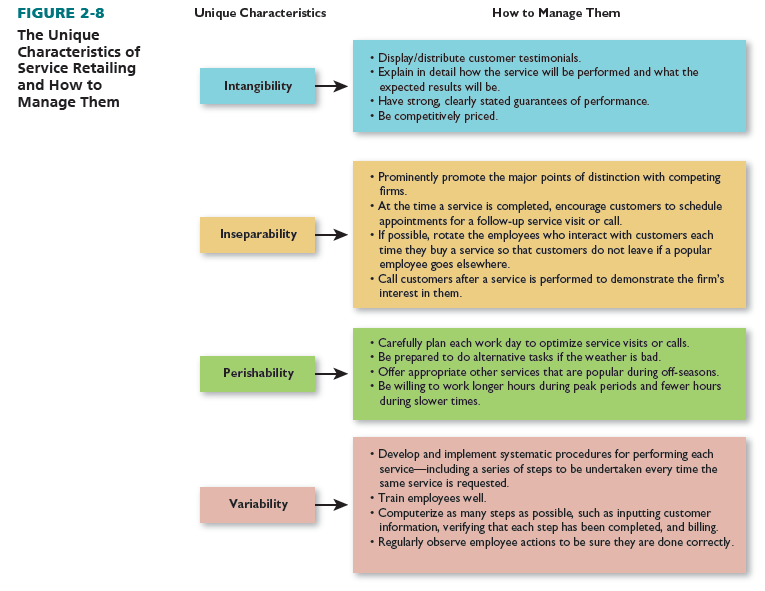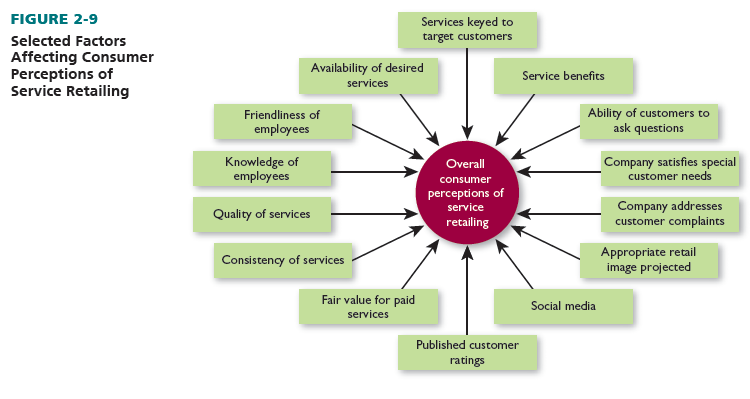Consumer interest in services makes it crucial to understand the differences in relationship building between retailers that market services and those that market goods. This applies to store-based and nonstore-based firms, those offering only goods or services, and those offering goods and services.
Goods retailing focuses on the sale of tangible (physical) products. Service retailing involves transactions in which consumers do not purchase or acquire ownership of tangible products. Some retailers engage in either goods retailing (such as hardware stores) or service retailing (such as travel agencies); others offer a combination of the two (such as Best Buy selling PCs and offering fee-based Geek Squad services). The latter format is growing. Consider how many drugstores have equipment to process digital photos, how many department stores have cafes, how many hotels have gift shops, and so on.
Service retailing encompasses such diverse businesses as personal services, hotels and motels, auto repair and rental, and recreational services. In addition, although several services have not been commonly considered a part of retailing (such as medical, dental, legal, and educational services), they should be when they entail final consumer sales. There are three basic kinds of service retailing:
- Rented-goods services, whereby consumers lease and use goods for specified periods of time. Tangible goods are leased for a fixed time, but ownership is not obtained and the goods must be returned when the rental period is up. Examples are Hertz car rentals, carpet cleaner machine rentals from a supermarket, and video rentals at Redbox kiosks.
- Owned-goods services, whereby goods owned by consumers are repaired, improved, or maintained. In this grouping, the retailer providing the service never owns the good involved. Illustrations include watch repair, lawn care, and an annual air-conditioner tune-up.
- Nongoods services, whereby intangible personal services are offered to consumers who then experience the services rather than possess them. The seller offers personal expertise for a specified time in return for a fee; tangible goods are not involved. Some examples are accountants, stockbrokers, travel agents, real-estate brokers, and personal trainers.
Please note: The terms customer service and service retailing are not interchangeable. Customer service refers to the activities undertaken in conjunction with the retailer’s main business; they are part of the total retail experience. Service retailing refers to situations in which services are sold to consumers.
Four unique aspects of service retailing impact relationship building and customer retention: (1) The intangibility of many services makes a consumer’s choice of competitive offerings more difficult than with goods, (2) the service provider and his or her services are sometimes inseparable (thus localizing marketing efforts), (3) the perishability of many services prevents storage and increases risks, and (4) the human nature involved in many services makes them more variable.
The intangible (and possibly abstract) nature of some services makes it harder for a firm to develop a clear consumer-oriented strategy, particularly because many retailers (such as opticians, repairpeople, and landscapers) start service businesses on the basis of their product expertise. The inseparability of the service provider and his or her services means the owner-operator is often indispensable and good customer relations are pivotal. Perishability presents a risk that in many cases cannot be overcome. Thus, revenues from an unrented hotel room are forever lost. Variability means service quality may differ for each shopping experience, store, or service provider. See Figure 2-8.


Service retailing is much more dependent on personal interactions and word-of-mouth communication than goods retailing. According to Professor Leonard Berry, building customer-firm relationships benefits both parties: “For services that are personally important, variable in quality, and/or complex, many customers will desire to be relationship customers.” For example, financial, insurance, and hairstyling services have characteristics “that would cause many customers to desire continuity with the same provider, a proactive service attitude, and customized service delivery.”25
Figure 2-9 highlights several factors that consumers may consider in forming their perceptions about the caliber of the service retailing experience offered by a particular firm. The appendix at the end of this chapter presents an additional discussion on the unique aspects of operating a service retailing business.
Source: Barry Berman, Joel R Evans, Patrali Chatterjee (2017), Retail Management: A Strategic Approach, Pearson; 13th edition.

Hello.This article was really motivating, especially since I was looking for thoughts on this subject last couple of days.